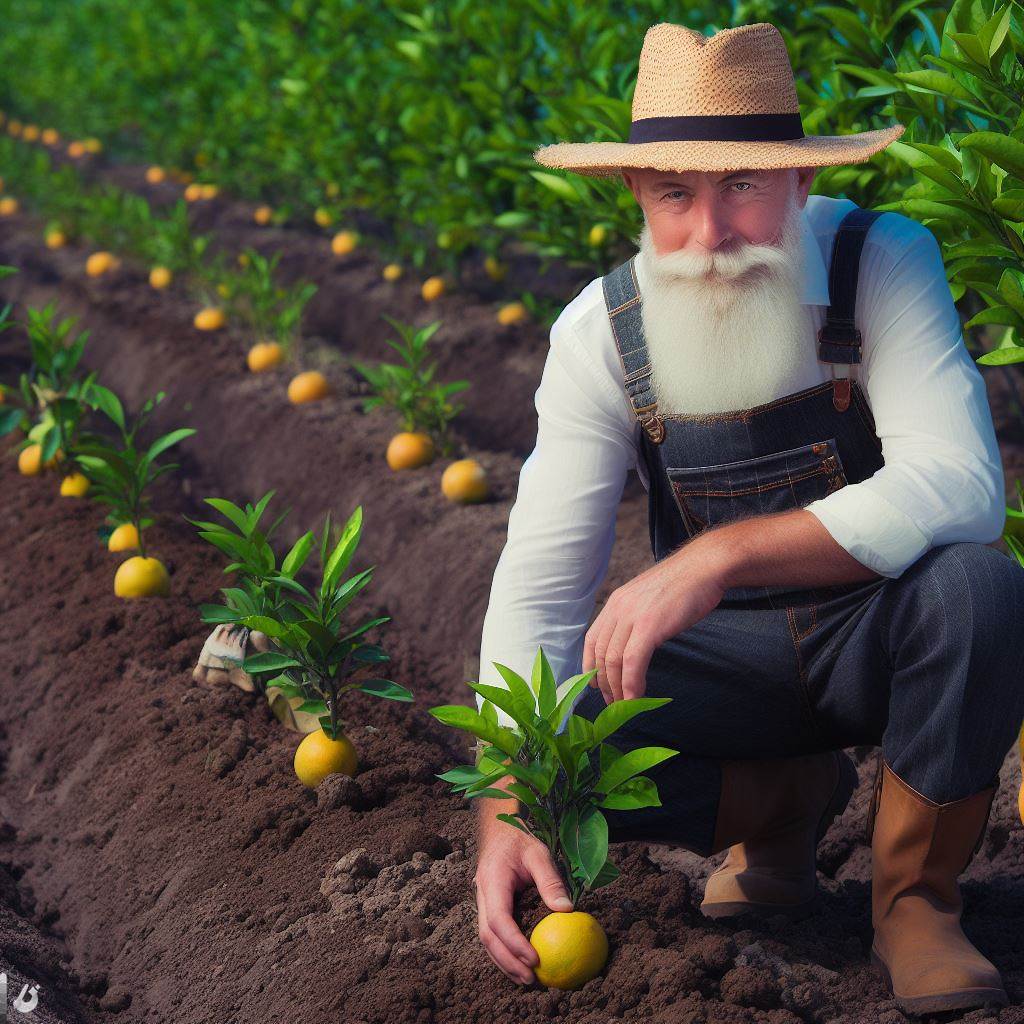Introduction
Citrus growing is a fascinating topic that has captivated many horticulture enthusiasts.
Citrus fruits play a vital role in our diet, providing essential nutrients and refreshing flavors.
In the sun-kissed orchards where the delicate dance of sunlight intertwines with the earth’s embrace, a compelling tale unfolds – “Fruits of Labor: A Citrus Grower’s Tale.”
Here, amidst the undulating rows of citrus trees, time seems to slow, allowing for the intricate interplay between human hands and the fertile soil.
Journey through the verdant landscapes where every leaf tells a story, and each blossom whispers the secrets of a dedicated cultivator.
In this enchanting narrative, the groves become a living canvas upon which the grower paints a masterpiece of passion, resilience, and unwavering commitment.
Through seasons of both abundance and scarcity, the rhythm of the orchard mirrors the ebb and flow of life, as the cultivator navigates the challenges bestowed by weather, pests, and the relentless passage of time.
This blog post aims to offer insights into the world of citrus growing from the perspective of a citrus grower.
Welcome to a world where the symphony of nature and human endeavor harmonize to yield the sweetest chapters of agricultural triumph.
“Fruits of Labor” beckons you to join this odyssey, where the bountiful harvest is not just a measure of the grower’s diligence but a testament to the enduring partnership between the land and those who tend to it with unyielding love.
The Journey of a Citrus Grower
The initial steps involved in starting a citrus farm
Land Selection and Acquisition
- Scout potential locations for optimal sunlight.
- Secure fertile land conducive to citrus cultivation, considering soil quality and drainage.
Choice of Citrus Varieties
- Research and select suitable citrus varieties based on climate and market demand.
- Plan for diversity to enhance resilience and meet consumer preferences.
The process of preparing the soil for planting citrus trees
Preparing the Soil
- Conduct thorough soil testing to determine nutrient levels.
- Implement necessary amendments, ensuring a nutrient-rich foundation for citrus growth.
- Set up an efficient irrigation system for consistent moisture.
Planting and Caring for Citrus Trees
- Adhere to proper spacing and planting techniques for healthy root development.
- Implement regular pruning and maintenance to shape trees and promote fruiting.
- Integrate pest and disease control measures to safeguard citrus orchards.
Embarking on the citrus-growing journey involves meticulous planning, from selecting the right land and citrus varieties to nurturing the soil and implementing effective care practices.
It’s a journey of dedication, where each step contributes to the eventual fruition of a thriving citrus orchard.
Read: Barns and Bonds: Community Farming
Challenges and Rewards
The challenges citrus growers face
Weather-related risks (frost, hurricanes)
Citrus growers face numerous challenges in their endeavor to cultivate and harvest these vibrant fruits.
One of the major hurdles they encounter is the unpredictable nature of weather-related risks.
Transform Your Agribusiness
Unlock your farm's potential with expert advice tailored to your needs. Get actionable steps that drive real results.
Get StartedFrost and hurricanes can damage or even decimate entire citrus orchards, leading to substantial financial losses.
Mitigating these risks often involves implementing protective measures, such as covering the trees during frosty nights or relocating them to safer areas during hurricane threats.
Dealing with pests and diseases
In addition to weather-related challenges, citrus growers must also contend with pests and diseases that can wreak havoc on their crops.
Invasive insects, such as citrus psyllids, can introduce harmful bacteria that cause diseases like citrus greening.
To combat these pests, growers rely on integrated pest management strategies, which include the use of beneficial insects, organic pesticides, and regular monitoring to detect and control outbreaks before they spread.
Market fluctuations and competition
Furthermore, citrus growers face the constant pressure of market fluctuations and competition.
The demand for citrus fruits can vary greatly, influenced by factors such as consumer preferences, dietary trends, and global trade dynamics.
Consequently, maintaining a stable and profitable citrus business requires adaptability, intelligent market analysis, and strategic decision-making.
The rewards and satisfaction of citrus farming
Despite the challenges, the rewards and satisfaction offered by citrus farming make it an incredibly fulfilling occupation.
The joy of watching trees grow and bear fruit
Witnessing the transformation of tiny seeds or saplings into majestic trees laden with ripe, juicy fruits brings immense joy to growers.
The process of nurturing the trees, witnessing their growth, and eventually harvesting the fruits showcases the cycle of life and the miracle of nature.
Savoring the taste of freshly harvested citrus fruits
The ultimate reward comes in the form of savoring the taste of freshly picked citrus fruits.
The explosion of flavor, the tangy juiciness, and the natural sweetness contribute to an unparalleled culinary experience.
Whether enjoyed alone, squeezed into refreshing juices, or incorporated into delectable recipes, the taste of homegrown citrus is unmatched in quality and freshness.
Creating a sustainable business and contributing to the local economy
Apart from personal satisfaction, citrus growers play a crucial role in the local economy.
By establishing and maintaining successful citrus farms, they create jobs, foster economic growth, and contribute to the vibrancy of their communities.
Moreover, the cultivation of citrus fruits often promotes sustainable agricultural practices, such as responsible water usage and preservation of biodiversity, further benefiting the environment and society at large.
In essence, the world of citrus farming is not without its challenges.
From weather-related risks to pest control and market competition, citrus growers face a myriad of obstacles.
However, the rewards and satisfaction derived from this labor of love make it all worthwhile.
The joy of nurturing trees, the pleasure of consuming freshly harvested citrus fruits, and the contribution to the local economy make citrus farming a fulfilling and sustainable endeavor.
Read: Tractor Tracks: Innovations in Farming

Seasonal Work and Harvesting
The seasonal work involved in citrus growing
Citrus growing involves a variety of seasonal tasks, essential for maintaining healthy trees and ensuring a bountiful harvest.
Throughout the year, citrus growers diligently prune and maintain their trees, closely monitor irrigation systems, and implement pest and disease prevention measures.
Showcase Your Farming Business
Publish your professional farming services profile on our blog for a one-time fee of $200 and reach a dedicated audience of farmers and agribusiness owners.
Publish Your ProfilePruning and tree maintenance during the off-season
During the off-season, pruning plays a vital role in citrus tree maintenance.
Growers carefully trim the branches to maintain tree structure, remove dead or diseased wood, and encourage proper fruit development.
Pruning also enhances air circulation and sunlight penetration, minimizing the risk of fungal infections and improving overall tree health.
Monitoring and managing irrigation throughout the year
Another critical aspect of citrus growing is monitoring and managing irrigation.
Growers must ensure that their trees receive adequate water throughout the year, particularly during dry spells.
Consistent moisture levels support healthy growth, nutrient uptake, and fruit development.
Modern irrigation systems with sensors and timers assist in maintaining optimal soil moisture levels, preventing both overwatering and underwatering.
Implementing pest and disease prevention measures
Pest and disease prevention is an ongoing effort that citrus growers undertake.
They establish integrated pest management programs, implement biological controls, and use targeted pesticides sparingly.
Regular scouting helps identify potential issues early on, allowing for timely intervention and minimizing crop damage.
Additionally, citrus growers employ cultural practices like removing fallen fruits and managing weeds to reduce the risk of pests and diseases.
The process of harvesting citrus fruits
Determining the optimal harvesting time
The process of harvesting citrus fruits requires precision and careful consideration.
Determining the optimal harvesting time is essential to ensure peak flavor and quality.
Growers monitor fruit size, color, and sugar content, aiming for the perfect balance.
Additionally, taste tests and laboratory analysis help guarantee the fruits’ maturity before harvest.
Utilizing techniques for hand-picking or mechanical harvesting
Harvesting techniques may differ based on the intended market and scale of operations.
Small-scale growers often rely on hand-picking, where skilled workers gently detach ripe fruits from the tree to prevent damage.
Large-scale operations may employ mechanical harvesting, utilizing specialized equipment to shake the trees, dislodging the ripe fruits, which are then collected from the ground.
Sorting, cleaning, and packing the harvested fruits
Once the fruits are harvested, they undergo a series of post-harvest processes.
Sorting ensures that only high-quality fruits meet consumer standards.
This involves removing damaged or defective fruits and categorizing them based on size and appearance.
Cleaning the fruits removes any dirt or residues before packing.
Finally, the fruits are carefully packed in containers or crates, ensuring proper ventilation and protection during transportation.
In general, citrus growing involves a range of seasonal work, including pruning, irrigation management, and pest prevention.
Harvesting citrus fruits involves determining the optimal time, employing suitable harvesting techniques, and post-harvest processes of sorting, cleaning, and packing.
The dedication and expertise of citrus growers ultimately contribute to the availability of fresh and flavorful citrus fruits.
Read: Tilling Tales: A Family Farm History
You Might Also Like: Her Soil, Her Story: Female Farmers’ Journeys
Citrus Industry and Future Perspectives
Provide an overview of the citrus industry’s significance
Economic impact and job creation
The citrus industry plays a crucial role in the economy, generating billions of dollars in revenue and creating numerous job opportunities.
Export and domestic market trends
Citrus fruits are not only popular domestically but also in the global market, with exports contributing significantly to the industry’s growth.
Current challenges and opportunities in the citrus industry
Rising competition from international markets
The citrus industry faces increasing competition from countries that offer similar fruits at lower prices, challenging the industry’s market share.
The growing popularity of organic and sustainable citrus farming
Consumers are increasingly concerned about the environmental impact and health aspects, creating opportunities for organic and sustainable citrus farming practices.
Technological advancements in pest control and fruit quality preservation
New technologies in pest control and fruit quality preservation enable citrus growers to enhance productivity and meet consumer expectations.
The future prospects and innovations in citrus growing
Advances in varietal development
Through research and development, new citrus varieties with improved taste, disease resistance, and longer shelf life are being introduced.
Sustainable farming practices and environmental stewardship
Citrus growers are adopting sustainable farming practices to reduce environmental impacts, conserve resources, and enhance long-term productivity.
Read: Soil and Sweat: The Reality of Farming
Conclusion
Throughout this blog post, we explored the laborious process of growing citrus fruits.
From carefully selecting the right variety of trees to nurturing them with proper care, it’s evident that citrus growing requires dedication and hard work.
As a citrus grower, I have come to appreciate the immense satisfaction that comes from seeing the fruits of my labor thrive and flourish.
It is truly a rewarding experience to witness the beautiful blossoms transform into delicious and vibrant citrus fruits.
Showcase Your Farming Business
Publish your professional farming services profile on our blog for a one-time fee of $200 and reach a dedicated audience of farmers and agribusiness owners.
Publish Your ProfileNext time you bite into a juicy orange or savor the tangy taste of a lemon, take a moment to reflect on the hard work and dedication that goes into growing these fruits.
Behind every citrus fruit, there is a mountain of effort, sweat, and love.
So, let’s not take these fruits for granted.
Let’s appreciate and acknowledge the citrus growers who work tirelessly to bring these delightful fruits to our tables.
The next time you enjoy a citrus treat, remember the story behind it and savor every bite with gratitude.




